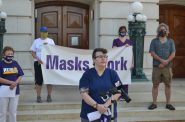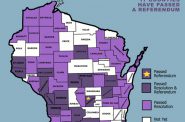High School Sweethearts Recall Open Housing Struggle
How Joyce and Ken McGhee persevered against racism.
Sixteen-year-old Joyce Wigley walked out of St. Boniface Catholic Church with a large group of teens in the summer of 1967. When they stepped out of the building their eyes began to burn, and they couldn’t see.
White people were throwing tear gas from the other side of a fence, a few feet away from the church.
This was the first time Wigley was tear gassed, but it wouldn’t be the last.
She and the other teens were participating in the marches to protest housing discrimination in Milwaukee with the NAACP Youth Council, led by the Rev. James Groppi.
It was at a Youth Council meeting in the basement of St. Boniface where Wigley met Ken McGhee, the man who would become her husband. After graduating from high school they were married in that very church.
Fifty years later, the McGhees vividly remember one particular day when they marched across the 16th Street Viaduct.
Once they reached the end of the bridge, chaos ensued. Ken McGhee recalls being surrounded by an angry white mob. They pelted eggs, broken glass and rocks at the young marchers.
The police threw tear gas at the marchers, forcing them to run in the direction of the counter-protesters, Ken McGhee said. When the two groups came together, fighting ensued.
“That will always be on my heart — just how hateful that really was,” said Joyce McGhee.
Despite the violence that occurred, the McGhees remained committed. They showed up at the picket line every day after the 16th Street bridge incident.
Ken McGhee said he still feels the effects from the marching he did in his youth. “My bones still hurt today. Some of the aches and pains we’re having in our 60s and 50s is kind of attributed to all the marching we did as a kid.”
For both the McGhees and Wigleys the marches were a family affair. Wigley went with her cousins and her younger brother, Chuck. At 8 years old, he was the youngest member of the Youth Council.
Ken McGhee’s older brother, Lee, was the Youth Council president. “For many years I was called ‘Lee’s brother,’” he said.
His parents were very supportive of his involvement in the Youth Council. They would often prepare meals for the marchers. However, he can recall one instance when they weren’t happy with the organization.
“The only time they were upset is when my brother and I went to jail the same night,” McGhee said with a chuckle.
That night, he went out with the Youth Council to picket the Fraternal Order of Eagles Club, an exclusively white social club where a musical group was supposed to be performing. A large group of protesters and patrons began to form in front of the club. When a band member opened his car door, he hit a protester in the back, and she screamed.
“When she screamed all hell broke loose,” Ken McGhee said.
Everyone began pushing and shoving. Police flooded the area. They began making arrests and hitting people in the unruly crowd with billy clubs.
“I was told I was hit several times, but things were moving so fast I don’t remember,” Ken McGhee said. During the chaos, he was arrested. When he was loaded into the paddy wagon his brother was already there in handcuffs.
“Now they’ll lie and say they were a part of it, and that they marched every day,” Ken McGhee said. “We know who marched every day because we did.”
Today, the McGhees still live on the North Side, in what they describe as a racially diverse neighborhood. They say they would “never dream of leaving.”
Ken McGhee said the open housing movement allowed many professionals to move out of his neighborhood. He recalls growing up with black police officers, doctors and attorneys living down the street from him.
“When open housing came they started to move to suburbs like Brown Deer and Sussex because they thought they had arrived,” he said. “We lost a lot of good role models in our community.”
Joyce McGhee, who retired from AT&T, and Ken McGhee, who retired from General Motors, are among the role models who remained.
“We want to show you don’t have to leave where you came from to be successful,” Ken McGhee said.
This story was originally published by Milwaukee Neighborhood News Service, where you can find other stories reporting on fifteen city neighborhoods in Milwaukee.
50 Years After The Marches
-
Pandemic Shines Spotlight on Workers’ Struggle
 Sep 7th, 2020 by Erik Gunn
Sep 7th, 2020 by Erik Gunn
-
UW System Expects $212 million in Losses
![Van Hise Hall in the background. Photo by James Steakley (Own work) [CC BY-SA 3.0 (https://creativecommons.org/licenses/by-sa/3.0) or GFDL (http://www.gnu.org/copyleft/fdl.html)], via Wikimedia Commons](https://urbanmilwaukee.com/wp-content/uploads/2017/10/1017px-Ingraham_Van_Hise_carillon-185x122.jpg) May 8th, 2020 by Rich Kremer
May 8th, 2020 by Rich Kremer
-
51 of 72 Counties Now Back Fair Maps
 Apr 15th, 2020 by Matt Rothschild
Apr 15th, 2020 by Matt Rothschild
















I am so so sorry for all you went through…but I do honor and celebrate your determination and successes! Yes, you are the role models that our community needs…I truly believe that it won’t be the “city” or “government” or outside agencies that will have the most impact on creating and maintainig an alive and healthy community, no matter where anyone lives.
(I just finished reading my father’s “war journal” from WWII and now I realize where I learned love and strength, work ethic, etc and I am forever grateful)
It’s wonderful to read your story. You have a lot to tell us and inspire us. The determination and faith that it took to keep doing day after day is nobel. Thanks for reminding us what is important.